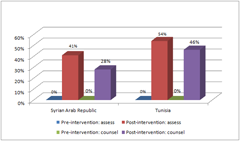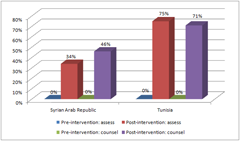 What is “care for development” in IMCI about?
What is “care for development” in IMCI about?
The early years of life are critical for the child's physical growth and development, which are intimately related. Care for development is about caregivers’:
responding to the child's needs for care with loving attention;
providing a safe environment ;
stimulating their children through play and communication with them.
“Care for development” in IMCI is integrated with other health and nutrition actions, to provide the greatest impact.
What is the approach followed in IMCI care for development?
The approach followed is the counselling approach. The choice of the approach came after a review of three approaches to support child development:
Monitoring the child’s progress on developmental milestones ;
Screening for developmental delays;
Counselling families on how to support the development of their children.
The first approach is about what the healthy child should be able to do at various ages or stages. Potential problems with this approach include a focus on what the child is (or is not) doing, with little help for the caregiver and support for behavioural change.
The screening approach is about assessing children to identify those in need of special help. It is a difficult approach to develop, requires time and is less reliable in young children. The resources for special care for the identified children in need—the action—are often limited in many developing countries. There may also be serious consequences resulting from misclassifying children.
The counseling approach focuses on improving the interaction of the caregiver with the child. It is based on what the caregiver can do. Counselling adapts as the child develops to help move her/him to the next step.
What does the approach in “care for development “ do?
The counseling approach promotes mental and social development by responding to a child’s needs for care and through talking, playing and providing a stimulating environment.
The approach:
improves the knowledge and skills of mothers and other caregivers on active and responsive feeding to improve nutrition and growth; and
introduces play and communication activities to improve interaction between caregiver and child to stimulate growth and learning.
Which steps do the guidelines on “Care for development” include?
The guidelines include the steps of “assess”,”identify problems” and “counsel” on care for development. The health care provider:
observes the caregiver and the child from the beginning of the consultation to see how they interact with each other;
asks the caregiver questions on how s/he plays and communicates with the child;
compares the caregiver’s answers with the recommendations for care for development for the child’s age;
identifies problems in care for development;
counsels the caregiver about care for development problems using good communication skills;
refers the child and caregiver if necessary.
The health care provider gives recommendations based on the assessment on actions which:
are appropriate for the child's age and skills;
are designed to be done by the caregivers;
can be followed with simple items in the home as “ toys”;
can be demonstrated first to the caregiver and then practised by her/him before she goes home.
Whom are the WHO guidelines on “Care for development” for?
To have the greatest impact, the guidelines are meant especially for:
All children < 2 years of age (the “ critical window”);
Children under-five who are most at risk (malnourished, very low weight- for-age or anaemic).
Interventions should target poor children as a priority, as they are most in need and benefit the most.
What should interventions on care for development do?
Interventions on care for development should:
start with improving the skills of health care providers, whether at the health facility or in the community, using the IMCI care for development guidelines;
provide tools for follow-up and supervision;
link facility-based interventions to community interventions for greater impact;
be integrated with other health and nutrition interventions, including breastfeeding.
Findings from IMCI follow up visits: health providers’ performance before and after training on care for development, Syrian Arab Republic and Tunisia, 2002
 Improvement of physicians performance on care for development
Improvement of physicians performance on care for development Improvement of nurses performance on care for development
Improvement of nurses performance on care for development
Caretaker satisfaction
Qualitative information from follow up visits suggested a high level of satisfaction among caregivers about this approach and that child nutrition, behaviour and sleep improved after caregivers started communicating and playing with their children more effectively.


